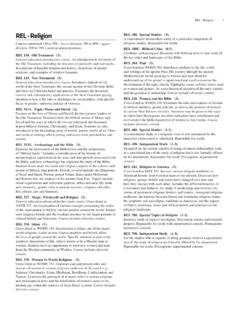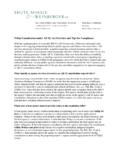Transcription of Risk-Based Decision-Making and Federal Facilities Cleanup ...
1 Risk-Based Decision-Making and Federal Facilities Cleanup : A Workshop for Tribal Decision-makers Lakewood, Colorado March 14-16, 2000 International Institute for Indigenous Resource Management Environmental Protection Agency Department of Energy, Center for Risk Excellence Tulane University Medical Center Plenary Presentation cultural LEGACIES1 Stuart Harris Confederated Tribes of the Umatilla Indian Reservation Tots Maywe. Good morning. I am Stuart Harris. I am a staff scientist for the Confederated Tribes of the Umatilla Indian Reservation, or CTUIR. My job is to analyze the risks to our people from pollution impacts. My primary work effort is focused on addressing nuclear pollution and associated Cleanup at the Department of Energy s Hanford Site. The CTUIR is a sovereign government that has a legal interest in the natural resources upon which the CTUIR s treaty rights are based.
2 This includes lands of the Hanford Site. The Umatilla Indian Reservation, located near Pendleton, Oregon, is occupied by descendants of three Columbia Plateau Tribes the Cayuse, the Walla Walla, and the Umatilla Tribes. Under the Treaty of 1855 [12 Stat. 945], the Tribes ceded lands to the United States yet retained rights to perform many activities on those lands, including but not limited to fishing, hunting, gathering roots and berries, and pasturing livestock. Effective exercise of these treaty rights depends on the health of the natural resources. The CTUIR government does not want the people exercising their treaty rights to be placed at risk. My people have to deal with a complex set of environmental, cultural and health impacts, complete with numerous entrenched interests such as agribusiness, mining, and government, and competing value sets vying for ever decreasing resources.
3 We use a process that includes education, law, analysis, research, and planning. Each of these processes is filtered and translated through our culture. The CTUIR culture, which has co-evolved with nature through thousands of ecological education, has provided its people with their unique and valid version of holistic environmental management. Throughout the year, when the CTUIR traditional American Indian participates in activities such as hunting and gathering for foods, medicines, 1 Adapted from Plenary Address, Society of Risk Analysis Annual Meeting, December 7, 1998, Phoenix, AZ. The author may be contacted at ceremonies, and subsistence, the associated activities are as important as the end product. In the Judeo-Christian tradition, an analogy would be kosher dietary practices.
4 All of the foods and implements gathered and manufactured by the traditional American Indian are interconnected in at least one, but more often in many ways. The people of the CTUIR community follow cultural teachings or lessons brought down through history from the elders. Our individual and collective well-being is derived from membership in a healthy community that has access to ancestral lands and traditional resources and from having the ability to satisfy the personal responsibility to participate in traditional community activities and to help maintain the spiritual quality of our resources. This is an ancient oral tradition of cultural norms. The material or fabric of this tradition is unique, and is woven into a single tapestry that extends from far in the past to long into the future. In order to encompass the wide range of factors directly tied to the traditional American Indians of the CTUIR, a risk assessment has to be designed and scaled appropriately.
5 Only our people, the Tetokin, know what is good for the Tetokin people. We don t give our knowledge away as the cost of buying improved risk assessments that may or may not result in lowered exposures and better resource protection. Within the Decision-Making context of CERCLA and NEPA, risk assessment as it now stands is woefully inadequate for addressing Native American concerns. In effect, a re-structuring of the risk assessment process must occur in order to address the overwhelming problems including but not limited to: Lack of breadth of coverage, Lack of integration and deficiencies related to not addressing the CTUIR traditional American Indian s quality of life, The interrelated eco-culture and their unique exposure parameters and pathways. Unfortunately, the processes, the approach, and even the necessity to account for traditional American Indian lifestyles have gone unnoticed in classical risk assessments that typically focus on suburban lifestyles.
6 A risk from nuclear or hazardous waste that potentially affects one person of the CTUIR community may have lasting impacts throughout all of the community. In other words, a wave of risk can ripple outwards, affecting all of the individuals in our culture, just like a wave generated and propagated in a tapestry. If a culture dies, the only remnants are the material artifacts. In the event of the unthinkable happening, a continuously sustainable natural resource based material culture such as the CTUIR would rapidly disperse into the natural environment leaving no trace of the living CTUIR culture. The need for understanding the pathways that directly involve the traditional American Indian cannot be understated. Our ties to the environment are much more complex and intense than is generally understood. Because my tribal culture and religion are essentially synonymous with and inseparable from the land, the quality of the socio- cultural and eco- cultural landscapes is as important as the quality of individual natural resources or ecosystem integrity.
7 Many cultural and religious activities also occur in natural settings, and would increase exposures over suburban factors. The difference in mean exposures between an average suburban resident and an average traditional-subsistence person co-located in a particular contaminated area are due to differences in assumptions such as the percentage of plant material grown locally. The actual percentile will vary with the contaminants that are present in particular media, the pathways that are applicable, and other habitat- and climate-specific factors. The average subsistence lifestyle is equivalent to at least a 90th percentile of the average suburban exposure. Initial sensitivity analyses show that the difference between means of the two types of lifestyles ranges from 2 to 100 fold. The magnitude of the difference is due to the fact that the traditional way of life as it is currently practiced is more than just a suburban lifestyle with extra fish consumption.
8 There are certain exposures that are potentially underestimated for a broad cross section of tribal members. For example, animal parts have many non-food uses that could contribute to personal exposure: teeth and bones are used for decoration and whistles, skin is made into clothing, fish belly fat is rendered and used as a base for body paint, and so on. As with game, plants are used for more than just nutrition. Daily cleaning, preparation and ingestion of stored plants, and crafting of plant materials into household goods occurs throughout the year. The cattail provides an example: in the spring the shoots are eaten, the roots are consumed, and the fibrous stalks are split, woven or twisted into baskets, mats or cookhole layers. Later in the year the pollen is used for breads. Each of these activities involves the selection and gathering of the plants from marshy areas, sorting, cleaning, stripping, peeling, splitting, chewing, and using various parts of the plant.
9 Our basket weavers typically hold plant materials in their mouths during separation of the inner and outer bark. In addition to the plant itself, they contact sediment and water, and generally there will be cuts on the hands from the sharp edges that could facilitate dermal absorption during gathering, preparation, and weaving. Likewise, the scenarios for children and other segments of our populations with greater exposures or greater sensitivities are not explicitly called out. These factors are part of both the uncertainty analysis and the risk characterization. There are additional co-risk factors that could modify both exposure and sensitivity, such as: Individual cancer and non-cancer risk using the subsistence exposure scenario, Exposure to future populations, Community-level exposure burdens Additional background exposures such as evidenced by fish advisories, Underlying health problems using health statistics where available, Influence of underlying nutritional status, dietary quality, and the physiological effects of substituting a modern diet if the traditional diet is not available, Socioeconomic status and access to health care Potential differences in biochemical genetics and ethnopharmacology.
10 It is clear that evaluating impacts to a traditional way of life would include environmental quality and community quality of life in addition to personal exposures to contaminants. Given this complex set of factors, along with the sovereign standing that my government has, I have found it useful to express my work within general guiding principles. There are some overriding principles, such as stewardship, trusteeship, and treaty compliance that apply to every aspect of my job. When we combine those principles with sustainable environmental management and a naturally integrated and holistic perspective, this leads us to some core performance measures that are reflected in my tribal mission statement. The things that are important to my tribal policy makers are: 1. Continuity and well-being of my people and our land, 2.

